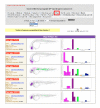CONDOR: a database resource of developmentally associated conserved non-coding elements
- PMID: 17760977
- PMCID: PMC2020477
- DOI: 10.1186/1471-213X-7-100
CONDOR: a database resource of developmentally associated conserved non-coding elements
Abstract
Background: Comparative genomics is currently one of the most popular approaches to study the regulatory architecture of vertebrate genomes. Fish-mammal genomic comparisons have proved powerful in identifying conserved non-coding elements likely to be distal cis-regulatory modules such as enhancers, silencers or insulators that control the expression of genes involved in the regulation of early development. The scientific community is showing increasing interest in characterizing the function, evolution and language of these sequences. Despite this, there remains little in the way of user-friendly access to a large dataset of such elements in conjunction with the analysis and the visualization tools needed to study them.
Description: Here we present CONDOR (COnserved Non-coDing Orthologous Regions) available at: http://condor.fugu.biology.qmul.ac.uk. In an interactive and intuitive way the website displays data on > 6800 non-coding elements associated with over 120 early developmental genes and conserved across vertebrates. The database regularly incorporates results of ongoing in vivo zebrafish enhancer assays of the CNEs carried out in-house, which currently number approximately 100. Included and highlighted within this set are elements derived from duplication events both at the origin of vertebrates and more recently in the teleost lineage, thus providing valuable data for studying the divergence of regulatory roles between paralogs. CONDOR therefore provides a number of tools and facilities to allow scientists to progress in their own studies on the function and evolution of developmental cis-regulation.
Conclusion: By providing access to data with an approachable graphics interface, the CONDOR database presents a rich resource for further studies into the regulation and evolution of genes involved in early development.
Figures





Similar articles
-
Comparative genomics using Fugu reveals insights into regulatory subfunctionalization.Genome Biol. 2007;8(4):R53. doi: 10.1186/gb-2007-8-4-r53. Genome Biol. 2007. PMID: 17428329 Free PMC article.
-
Comparative genomics using fugu: a tool for the identification of conserved vertebrate cis-regulatory elements.Bioessays. 2005 Jan;27(1):100-7. doi: 10.1002/bies.20134. Bioessays. 2005. PMID: 15612032 Review.
-
Evolution of vertebrate genes related to prion and Shadoo proteins--clues from comparative genomic analysis.Mol Biol Evol. 2004 Dec;21(12):2210-31. doi: 10.1093/molbev/msh245. Epub 2004 Sep 1. Mol Biol Evol. 2004. PMID: 15342797
-
The Evolution of Bony Vertebrate Enhancers at Odds with Their Coding Sequence Landscape.Genome Biol Evol. 2015 Aug 6;7(8):2333-43. doi: 10.1093/gbe/evv146. Genome Biol Evol. 2015. PMID: 26253316 Free PMC article.
-
Organization of conserved elements near key developmental regulators in vertebrate genomes.Adv Genet. 2008;61:307-38. doi: 10.1016/S0065-2660(07)00012-0. Adv Genet. 2008. PMID: 18282512 Review.
Cited by
-
Identification and characterization of lineage-specific highly conserved noncoding sequences in Mammalian genomes.Genome Biol Evol. 2012;4(5):641-57. doi: 10.1093/gbe/evs035. Epub 2012 Apr 13. Genome Biol Evol. 2012. PMID: 22505575 Free PMC article.
-
Genome-wide identification of coding and non-coding conserved sequence tags in human and mouse genomes.BMC Genomics. 2008 Jun 11;9:277. doi: 10.1186/1471-2164-9-277. BMC Genomics. 2008. PMID: 18547402 Free PMC article.
-
A comprehensively molecular haplotype-resolved genome of a European individual.Genome Res. 2011 Oct;21(10):1672-85. doi: 10.1101/gr.125047.111. Epub 2011 Aug 3. Genome Res. 2011. PMID: 21813624 Free PMC article.
-
Variable locus length in the human genome leads to ascertainment bias in functional inference for non-coding elements.Bioinformatics. 2009 Mar 1;25(5):578-84. doi: 10.1093/bioinformatics/btp043. Epub 2009 Jan 25. Bioinformatics. 2009. PMID: 19168912 Free PMC article.
-
Sequencing of the sea lamprey (Petromyzon marinus) genome provides insights into vertebrate evolution.Nat Genet. 2013 Apr;45(4):415-21, 421e1-2. doi: 10.1038/ng.2568. Epub 2013 Feb 24. Nat Genet. 2013. PMID: 23435085 Free PMC article.
References
-
- Woolfe A, Goodson M, Goode DK, Snell P, McEwen GK, Vavouri T, Smith SF, North P, Callaway H, Kelly K, Walter K, Abnizova I, Gilks W, Edwards YJ, Cooke JE, Elgar G. Highly conserved non-coding sequences are associated with vertebrate development. PLoS Biol. 2005;3:e7. doi: 10.1371/journal.pbio.0030007. - DOI - PMC - PubMed
Publication types
MeSH terms
Grants and funding
LinkOut - more resources
Full Text Sources
Other Literature Sources

